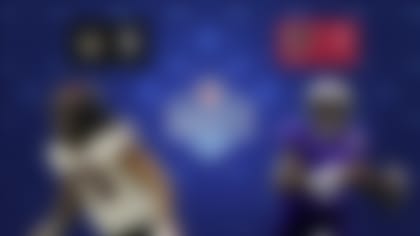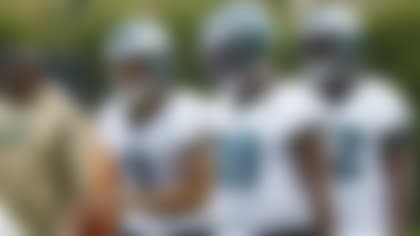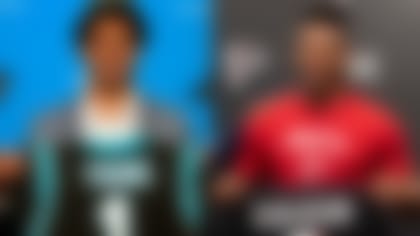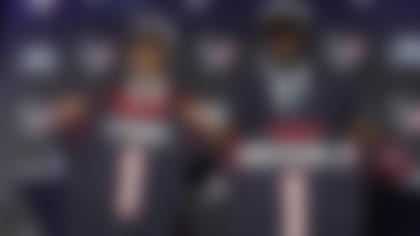Why provide instant grades on the selections of prospects who have yet to take an NFL snap? Well, you're reading this, aren't you? Considering the makeup of every roster and the factors surrounding each pick, Eric Edholm executes a division-by-division assessment of the 2023 NFL Draft. Keep in mind that these grades are based on draft hauls alone -- picks traded for veteran players were not taken into account. Below is the AFC East report card.
Round 1
- Utah TE Dalton Kincaid (No. 25 overall)
Round 2
- Florida OG O'Cyrus Torrence (No. 59)
Round 3
- Tulane LB Dorian Williams (No. 91)
Round 5
- Florida WR Justin Shorter (No. 150)
Round 7
- Mississippi OG Nick Broeker (No. 230)
- Oregon State CB Alex Austin (No. 252)
All offseason, I campaigned for the Bills to add a starter-quality slot receiver, and that's what they did in Round 1 -- just not the way I imagined. It was a creative pivot (if that's even the word) to target Dalton Kincaid, leapfrogging the Cowboys via trade to do so at No. 25, right after a four-player run on wide receivers (picks No. 20-23). If Kincaid is healthy, he's an immediate target for Josh Allen, and the Bills can change their stripes and become more of a 12-personnel team, having Kincaid and Dawson Knox out there together and really putting defenses in a bind. If Kincaid and Knox are joined on the field by Stefon Diggs, Gabe Davis and James Cook, opponents will be asked to stop five able, diverse pass catchers at once -- pretty tough. After acquiring Kincaid, the Bills grabbed two prospects well-liked by other teams' scouts: O'Cyrus Torrence and Dorian Williams, both of whom have starting potential at thinner positions. Justin Shorter underachieved at Penn State and always left you wanting a bit more at Florida, but if he's viewed as a low-usage/high-yield WR4, the pick is a decent investment. Nick Broeker adds to the interior OL depth and can also pinch-hit at tackle, so there's a path for him to make the roster. Alex Austin's length and knack for playmaking might make him a decent late steal, if he can contribute on special teams, too. I thought Buffalo maybe would draft a defensive tackle (or two), given that almost every DT on the roster will be up for free agency next offseason, but on the whole, this is a good class from a contender picking at the back ends of most rounds.
Round 1
- Oregon CB Christian Gonzalez (No. 17 overall)
Round 2
- Georgia Tech DE Keion White (No. 46)
Round 3
- Sacramento State LB Marte Mapu (No. 76)
Round 4
- Troy C Jake Andrews (No. 107)
- Maryland K Chad Ryland (No. 112)
- Eastern Michigan OG Sidy Sow (No. 117)
Round 5
- UCLA OG Atonio Mafi (No. 144)
Round 6
- LSU WR Kayshon Boutte (No. 187)
- Michigan State P Bryce Baringer (No. 192)
- Liberty WR Demario Douglas (No. 210)
- Michigan State CB Ameer Speed (No. 214)
Round 7
- Jackson State CB Isaiah Bolden (No. 245)
From a league-value standpoint, Christian Gonzalez and Keion White could be considered smart and perhaps safe picks by New England to kick things off. Corner was a need, and Gonzalez's length and athleticism give the Patriots -- who landed him after trading down from No. 14 to No. 17 -- even more flexibility, coverage-wise. They'll ask him to be a more physical tackler and maximize his traits further, but this could be a big hit in a year or two. White was a bit of a late bloomer in college and could have limited upside, but he's a multi-position performer with elite athletic traits. It's clear with Matt Groh overseeing the past two drafts that the Patriots have put more emphasis on upgrading the athletic quotient. Marte Mapu was a classic Day 2 Patriots pick, matching sort of a Kyle Dugger template with excellent special-teams value. Spending three picks on interior offensive linemen and two on specialists is the Patriots' way of reminding you that they do business a bit differently than other teams, but that approach has paid off for them in the past. Of those picks, Sidy Sow (who has some tackle versatility), Atonio Mafi and Bryce Baringer seem to me to have the best chance to redeem their draft value. There was reason for excitement in Round 6 with the selections of Kayshon Boutte and Demario Douglas. Both could end up making this team in August. Also keep an eye on Isaiah Bolden, who could be a freaky-traits steal. I thought a tight end might be on the menu, and they were reportedly interested in trading back into Round 1 late; might Dalton Kincaid have been their guy?
Round 1
- Iowa State edge Will McDonald IV (No. 15 overall)
Round 2
- Wisconsin C Joe Tippmann (No. 43)
Round 4
- Pittsburgh OT Carter Warren (No. 120)
Round 5
- Pittsburgh RB Israel Abanikanda (No. 143)
Round 6
- Western Michigan LB Zaire Barnes (No. 184)
- LSU CB Jarrick Bernard-Converse (No. 204)
Round 7
- Old Dominion TE Zack Kuntz (No. 220)
Considering the major need at offensive tackle, the pick of edge rusher Will McDonald IV was a stunner early on. The Jets had to know that dropping down two slots in Round 1 as part of the trade with Green Bay for Aaron Rodgers could cost them a shot at one of the top blockers in this class. Such was the price of doing business; Broderick Jones was snagged by the Steelers at No. 14, one pick ahead of New York, after Pittsburgh traded with the Patriots to move into that position. We agree that McDonald could be a terror off the edge if he's not asked to rush from a 4i alignment as much as he did for the Cyclones. Was it the biggest need? The best value? Maybe not, but it could be a move that pays off down the road. It feels like the Jets were very fortunate to land Joe Tippmann and Carter Warren where they did. Tippmann received some late Round 1 buzz, and I thought Warren could go late in the third. Both could be in line to start at some point this season, perhaps earlier than some realize. The selection of Israel Abanikanda could end up being a real hit. With Breece Hall coming off an ACL injury and Michael Carter still needing to prove his worth, "Izzy" could earn a role quickly and contribute right away with his vision and burst. I thought the Jets might consider boosting their linebacker and DB depth a tad earlier than they did with the selections of Zaire Barnes and Jarrick Bernard-Converse, but both could crack the roster via special teams. And even with the Jets pretty deep at tight end, it was worth taking a risk in Round 7 on Zack Kuntz, a likely practice-squad developmental player. The Jets certainly brushed off age as a concern, as most of the picks will be between 23 and 24 years old as rookies. On the whole, it looks like a solid draft class.
Round 2
- South Carolina CB Cam Smith (No. 51 overall)
Round 3
- Texas A&M RB Devon Achane (No. 84)
Round 6
- Stanford TE Elijah Higgins (No. 197)
Round 7
- Michigan OT Ryan Hayes (No. 238)
The Dolphins had to make the most of their diluted allotment of picks this year. The selection of cornerback Cam Smith surprised me slightly at first, but it didn't take long for me to realize it might be a pretty savvy approach. First, Miami's slate of opponents next season will include a slew of good quarterbacks, including new Jets QB Aaron Rodgers (twice). Second, Miami's CB depth might look good on paper, but that's assuming ideal health for Nik Needham and Xavien Howard, which can't be assured. Third, it's never bad to have talented, versatile corners. GM Chris Grier having a mole inside the Gamecocks facility (Grier's son, Landon Grier, also plays DB at South Carolina) couldn't have hurt in terms of figuring out what kind of person Smith is. If I needed some time to appreciate the Smith pick, the selection of Devon Achane made immediate sense. He's always going to be a player who'll require a clear (perhaps limited) role and some schemed-up touches, but give him a runway, and he's gone. This is a dangerously fast offense with him, Tyreek Hill and Jaylen Waddle on the field. Elijah Higgins is an interesting hybrid player who isn't all that shifty and never really was a red-zone threat for the Cardinal. But in Miami, his skill set could flourish if he's serving as a middle-of-the-field alternative to the outside receivers. He's best on slants and seam routes and has sneaky straight-line acceleration. Ryan Hayes was a little beat up in Senior Bowl one-on-ones and might be limited to right tackle in the NFL, but the Dolphins were smart to add more OT competition.
Follow Eric Edholm on Twitter.
















